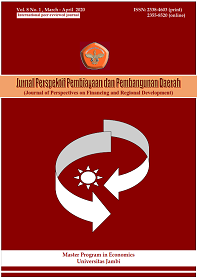Sustainable food crop production in karst area of Parigi, Pangandaran, West Java: preliminary study
DOI:
https://doi.org/10.22437/ppd.v8i1.7599Keywords:
Karst region, Land conservation, Local tree, RiceAbstract
Karst formations in Selasari and Parakanmanggu Village of Parigi District, Pangandaran Regency, West Java includes dolines, subterranean stream, springs, and karst hills are useful for agriculture. The purpose of this study was to 1) identifiy the used of karst area for rice cultivation and local trees in karst area; 2) evaluate the benefit of rice cultivation and local tree for local communities and 3) asses the legal aspect for supporting food crop production. The study was done using qualitative-descriptive method with the primary data obtained from field observations, soil analysis, local tree identification, and interviews. Secondary data was obtained from the Regional Government and the National Geological Agency. The results showed that rice cultivation has been carried out in suitable soil by using simple and rainfed irrigation. Local fruit, herbs, timber and shade-ornamental tree grow naturally on the karst area. Tree logging without significant revegetation caused water supply shortage so that farmers only grow rice once a year. Athough the rice productivity of both villages is lower than average rice productivity of Pangandaran Regency, rice is important to support local inhabitant’s consumption and family income. Land Use Plan year 2018 regulates the general provisions on zoning regulations for agriculture in susceptible area but the regulation does not mention the karst areas. This study suggested that tree conservation is needed to maintain the existence of rice fields. Land use planning for agriculture in the region must be based on integrated considerations of rice cultivation and local tree conservation.
Downloads
References
Astalin, P.K., (2013). Qualitative research designs: a conceptual framework. International, Journal of Social Science & Interdisciplinary Research, 2(1), 118-124.
Atalay, I., (1991). Soil forming in the karstic terrains of Turkey. Bulletin of Geomorphology, 19, 139-144.
Abdulrachman, A., Mejaya, M.J., Sasmita, P., & Guswara, A., (2013). Pengelolaan Tanaman Terpadu Padi Sawah Irigasi. Sukamandi: Balai Besar Penelitian Tanaman Padi Badan Penelitian dan Pengembangan Pertanian Kementerian Pertanian.
Baker, T.W., & Groves, C.G., (2008). Water Quality Impacts from Agricultural Land Use in Karst Drainage Basins of SW Kentucky and SW China. Proceeding of The Third Interagency Conference on Research in the Watersheds, 8-11 September 2008, Estes Park, CO. pp 103-116.
Bot, A., & Benites, J., (2005). The importance of Soil Organic Matter: Key to Drought-Resistant Soil and Sustained Food and Production. Rome: Food and Agriculture Organization of the United Nations.
Eviati, & Sulaeman, (2009). Analisis Kimia Tanah, Tanaman, Air, dan Pupuk: Petunjuk Teknis. Bogor: Balai Penelitian Tanah.
Efe, R., (2014). Ecological properties of vegetation formation on karst terrains in the Central Taurus Mauntains (Southern Turkey). Procedia - Social and Behavioral Sciences, 120(2014) 673 – 679.
Guo, Y., Wang, B., Mallik, A.U., Huang, F.U., Xiang, W., Ding, T., Wen, S., Lu, S., Li, D., He, Y., & Li, X., (2017). Topographic species–habitat associations of tree species in a heterogeneous tropical karst seasonal rain forest, China. Journal of Plant Ecology, 10(3), 450–460.
Hartatik, W., Sulaeman, & Kasno, A., (2006). Perubahan Sifat Kimia Tanah dan Ameliorasi Sawah Bukaan Baru. In Fakhuddin, A (Ed). Lahan Sawah Bukaan Baru (pp 53-75). Bogor: Balai Penelitian Tanah, Badan Penelitian dan Pengembangan Pertanian, Kementrian Pertanian.
Hartmann, A., Goldscheider, N., Wagener, T., Lange, J., & Weiler, M., (2014). Karst water resources in a changing world: review of hydrological modeling approaches. Reviews of Geophysics, 52(3), 218-242.
Klimchouk, A., (2004). Towards defining, delimiting and classifying epikarst: Its origin, processes and variants of geomorphic evolution. Speleogenesis and Evolution of Karst Aquifers, 2(1), 1-13.
Linhua, S., (1999). Sustainable development of agriculture in karst areas, South China. International Journal of. Speleology, 28B (1/4), 139-148.
Liu, Y., Liu, C., Wang, S., Guo, K., Yang, J., Zhang, X., & Li, G., (2013). Organic carbon storage in four ecosystem types in the karst region of southwestern China. PLoS ONE, 8(2), e56443.
Matsvange, D., Sagonda, R., & Kaundikiza, M., (2016). The role of communities in sustainable land and forest management: the case of Nyanga, Zvimba and Guruve districts of Zimbabwe. Jamba, 8(3), 281.
Nautiyal, S., Maikhuri, R.K., Semwal, R.L., Rao, K.S. & Saxena, K.G., (1998). Agroforestry systems in the rural landscape – a case study in Garhwal Himalaya, India. Agroforestry Systems, 41, 151–165.
Oseni Olalekan, A., Taiwo Abayomi, G., Ijaola Taiwo, O., & Yenusa Luqman, A., (2016). The effects of pH on the levels of some heavy metals in soil samples of five dumpsites in abeokuta and its environs. International Journal of Science and Research, 5(9), 1543-1545.
Radulović, M.M., (2013). A new view on karst genesis. Carbonates and Evaporites, 28(4), 383-397.
Roslinda, E., Ekyastuti, W., & Kartikawati, S.M., (2017). Social capital of community forest management on Nusapati Village, Mempawah District, West Kalimantan, Indonesia. Biodiversitas. 18(2), 548-554.
Rustam, Gunawan, G.G., Afrian, R., & Supratman, H., (2017). Penyusunan Peta Kawasan Bentang Alam Karst Kabupaten Pangandaran Bagian Barat Provinsi Jawa Barat. Report No.03/LAP- BGE.P2K/2017. Bandung: Program Penelitian, Mitigasi dan Pelayanan Geologi. Pusat tata air dan Geologi tata Lingkungan, Badan Geologi, Kementrian ESDM.
Urich, P.B., (2002). Land Use in Karst Terrain: Review of Impacts of Primary Activities on Temperate Karst Ecosystems. Science for Conservation 198. Department of Conservation, Wellington.
Wahab, M.I., Abdulrachman, S., Suprihanto, S., & Guswara, A., (2017). Daftar Periksa Budidaya Padi Sawah Lahan Irigasi. Sukamandi: Balai Besar Penelitian Tanaman Padi Badan Penelitian dan Pengembangan Pertanian Kementerian Pertanian,
Yang, H., Liang, J., Chen, J., & Cao, J., (2015). Soil calcium speciation at different geomorphological positions in the Yaji Karst Experimental Site in Guilin. Journal of Resources and Ecology, 6(4), 224-229.
Downloads
Published
How to Cite
Issue
Section
License
Copyright (c) 2020 Reginawanti Hindersah, Nia Kurniati, Dadang Epi Sukarsa, Rustam Rustam, Sondi Kuswaryan

This work is licensed under a Creative Commons Attribution 4.0 International License.

















